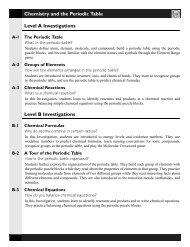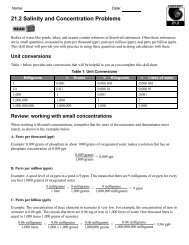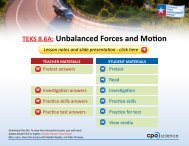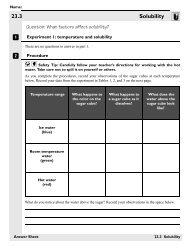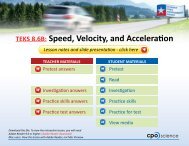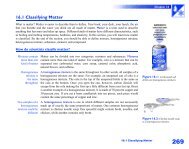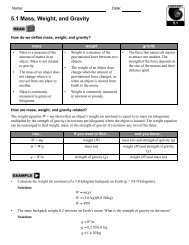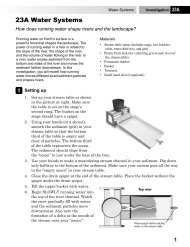6B Newton's Third Law - CPO Science
6B Newton's Third Law - CPO Science
6B Newton's Third Law - CPO Science
Create successful ePaper yourself
Turn your PDF publications into a flip-book with our unique Google optimized e-Paper software.
Newton’s <strong>Third</strong> <strong>Law</strong> Investigation <strong>6B</strong><br />
<strong>6B</strong> Newton’s <strong>Third</strong> <strong>Law</strong><br />
What happens when equal and opposite forces are exerted on a pair of<br />
Energy Cars?<br />
When you apply a force to throw a ball you also feel the force of<br />
the ball against your hand. That is because all forces come in<br />
pairs called action and reaction. This is Newton’s <strong>Third</strong> <strong>Law</strong> of<br />
motion. There can never be a single force (action) without its<br />
opposite (reaction) partner. Action and reaction forces always<br />
act in opposite directions on two different objects. You can set<br />
up two Energy Cars to study Newton’s <strong>Third</strong> <strong>Law</strong>.<br />
Materials<br />
• Energy Car<br />
• Data Collector and<br />
photogates<br />
• 1 Rubber band<br />
• 2 Steel marbles<br />
• Energy Car Link<br />
A<br />
Setting up and starting the experiment<br />
1. Set up the long straight track with a ball of clay on each stop. Use the bubble level to<br />
set the track level.<br />
2. Place one steel marble in each car, and wrap one car with a rubber band.<br />
3. Place two photogates 15-cm apart as shown in the photo.<br />
4. Place the 2 cars, “nose to notch” between the photogates.<br />
5. Squeeze the cars together and attach them with the Energy Car link.<br />
6. Center the attached car pair between the photogates so each is about to break the<br />
photogate’s beam, but do not actually break the beam. Check that both photogate<br />
indicator lights are still green. Make sure all 4 wheels of both cars are on the track.<br />
7. With a very quick upward motion, pull the link straight up and out from the cars.<br />
CAUTION: Wear eyeglasses or safety glasses to avoid injury.<br />
8. Observe the time through each photogate. Repeat several times.<br />
1
Investigation<br />
<strong>6B</strong><br />
Newton’s <strong>Third</strong> <strong>Law</strong><br />
B<br />
Thinking about what you observed<br />
a. What caused the two cars to move when you took out the link?<br />
b. According to Newton’s third law, the cars experienced equal and opposite forces. How can<br />
you tell this is true by looking at the time through each photogate?<br />
c. If one car was twice the mass of the other, would the cars still experience equal and<br />
opposite forces? Why or why not?<br />
C<br />
Changing the masses<br />
NOTE: Adding two steel marbles to the Energy Car doubles its mass.<br />
1. Try the experiment with the four combinations of mass shown above. Take the<br />
average of three trials for each and record your data in Table 1. CAUTION:<br />
Wear eyeglasses or safety glasses to avoid injury.<br />
2
Newton’s <strong>Third</strong> <strong>Law</strong> Investigation <strong>6B</strong><br />
2. Calculate the average speed for each trial and record in Table 1.<br />
Table 1: Energy Car Action–Reaction Data<br />
Marble pairings for<br />
connected cars<br />
Time through<br />
photogate (s)<br />
Speed<br />
(cm/s)<br />
A B A B A B<br />
0 marbles 2 marbles<br />
0 marbles 0 marbles<br />
2 marbles 0 marbles<br />
2 marbles 2 marbles<br />
D<br />
Applying what you have learned<br />
a. How does the speed of each car pair compare when masses are equal?<br />
b. How does the speed of each car compare when one of the pair has twice the mass?<br />
c. Explain how your speed data supports the idea that there are equal and opposite action<br />
and reaction forces acting on the cars.<br />
d. If the action and reaction forces are equal in strength, when the cars separate, why does<br />
one car move at a different speed than the other car when the masses are unequal? Hint:<br />
the answer involves the second law of motion.<br />
3



